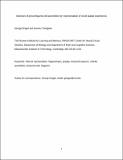Selection of preconfigured cell assemblies for representation of novel spatial experiences
Author(s)
Dragoi, George; Tonegawa, Susumu
DownloadTonegawa.pdf (436.0Kb)
OPEN_ACCESS_POLICY
Open Access Policy
Creative Commons Attribution-Noncommercial-Share Alike
Terms of use
Metadata
Show full item recordAbstract
Internal representations about the external world can be driven by the external stimuli or can be internally generated in their absence. It has been a matter of debate whether novel stimuli from the external world are instructive over the brain network to create de novo representations or, alternatively, are selecting from existing pre-representations hosted in preconfigured brain networks. The hippocampus is a brain area necessary for normal internally generated spatial–temporal representations and its dysfunctions have resulted in anterograde amnesia, impaired imagining of new experiences, and hallucinations. The compressed temporal sequence of place cell activity in the rodent hippocampus serves as an animal model of internal representation of the external space. Based on our recent results on the phenomenon of novel place cell sequence preplay, we submit that the place cell sequence of a novel spatial experience is determined, in part, by a selection of a set of cellular firing sequences from a repertoire of existing temporal firing sequences in the hippocampal network. Conceptually, this indicates that novel stimuli from the external world select from their pre-representations rather than create de novo our internal representations of the world.
Date issued
2013-12Department
Massachusetts Institute of Technology. Department of Biology; Massachusetts Institute of Technology. Department of Brain and Cognitive Sciences; Picower Institute for Learning and Memory; RIKEN-MIT Center for Neural Circuit GeneticsJournal
Philosophical Transactions of the Royal Society B: Biological Sciences
Publisher
Royal Society
Citation
Dragoi, G., and S. Tonegawa. “Selection of Preconfigured Cell Assemblies for Representation of Novel Spatial Experiences.” Philosophical Transactions of the Royal Society B: Biological Sciences 369, no. 1635 (December 23, 2013): 20120522–20120522.
Version: Author's final manuscript
ISSN
0962-8436
1471-2970